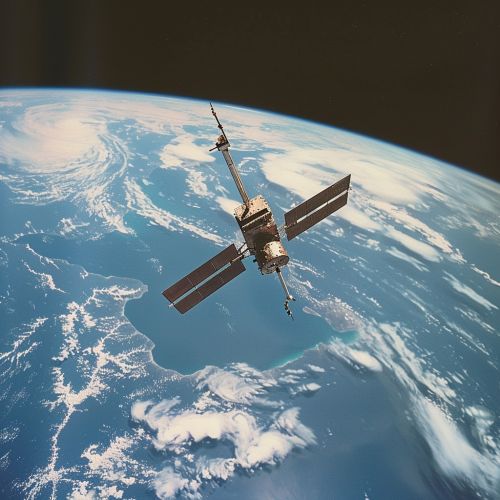Polar orbiting satellites
Introduction
Polar orbiting satellites are a class of artificial satellites that travel in a polar orbit, passing over the Earth's poles. These satellites are crucial for a variety of applications, including meteorology, earth observation, climate monitoring, and environmental monitoring. Unlike geostationary satellites, which remain fixed over a single point on the Earth's surface, polar orbiting satellites provide global coverage by orbiting from pole to pole.
Orbital Characteristics
Polar orbits are a type of low Earth orbit (LEO) with an inclination of approximately 90 degrees to the equator. This inclination allows the satellite to pass over both the North and South Poles during each orbit. Typically, these satellites orbit at altitudes ranging from 700 to 800 kilometers above the Earth's surface. The orbital period of a polar orbiting satellite is roughly 100 minutes, allowing it to complete about 14 orbits per day.
Applications
Meteorology
Polar orbiting satellites play a critical role in weather forecasting and meteorological research. They carry instruments that measure various atmospheric parameters, such as temperature, humidity, and wind speed. These measurements are essential for creating accurate weather models and forecasts. Notable meteorological satellites include the NOAA series and the MetOp satellites.
Earth Observation
Earth observation satellites in polar orbits provide high-resolution imagery of the Earth's surface. These images are used for a wide range of applications, including agriculture, forestry, urban planning, and disaster management. The Landsat program, operated by the United States Geological Survey (USGS), is one of the most well-known earth observation programs utilizing polar orbiting satellites.
Climate Monitoring
Polar orbiting satellites are indispensable for long-term climate monitoring. They provide continuous data on sea surface temperatures, ice cover, and atmospheric composition. This data is vital for understanding climate change and its impacts. The European Space Agency's Copernicus Programme includes several polar orbiting satellites dedicated to climate monitoring.
Environmental Monitoring
These satellites also contribute to environmental monitoring by tracking changes in land use, deforestation, and pollution levels. Instruments on board can detect greenhouse gases, aerosols, and other pollutants, providing valuable data for environmental protection agencies and researchers.
Instrumentation
Polar orbiting satellites are equipped with a variety of instruments to collect data. Common instruments include:
- Radiometers: Measure radiation emitted or reflected by the Earth's surface and atmosphere.
- Spectrometers: Analyze the spectral composition of light to identify different materials and gases.
- Radar: Used for surface mapping and measuring surface roughness and elevation.
- Lidar: Measures distances by illuminating the target with laser light and analyzing the reflected light.
Data Transmission and Processing
Data collected by polar orbiting satellites is transmitted to ground stations during each pass. These ground stations are strategically located around the world to ensure continuous data reception. The data is then processed and distributed to various users, including meteorologists, researchers, and government agencies.
Challenges and Limitations
Polar orbiting satellites face several challenges, including:
- Limited coverage time: Each satellite only passes over a specific location for a few minutes during each orbit, limiting the temporal resolution of the data.
- Atmospheric drag: Satellites in low Earth orbit experience atmospheric drag, which can reduce their operational lifespan.
- Data latency: The time required to transmit and process data can introduce delays, affecting real-time applications.
Future Developments
Advancements in satellite technology are continually improving the capabilities of polar orbiting satellites. Future developments include:
- Enhanced sensors: New sensors with higher resolution and greater sensitivity will provide more detailed and accurate data.
- Increased satellite constellations: Deploying multiple satellites in coordinated orbits will improve temporal resolution and data coverage.
- Improved data processing: Advances in artificial intelligence and machine learning will enhance data analysis and interpretation.
See Also
- Geostationary satellite
- Satellite imagery
- Remote sensing
- Earth observation satellite
- Weather satellite


References
- [NOAA Polar-Orbiting Satellites](https://www.nesdis.noaa.gov/NOAA-Polar-Orbiting-Satellites)
- [ESA Copernicus Programme](https://www.esa.int/Applications/Observing_the_Earth/Copernicus)
